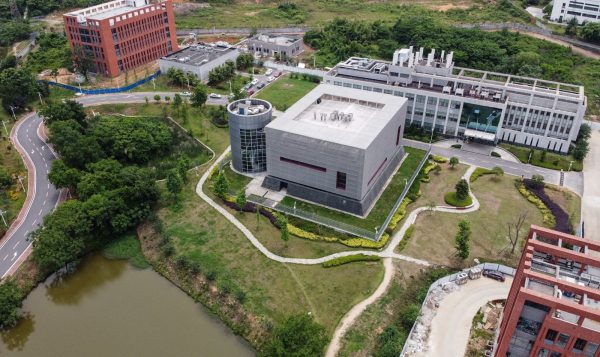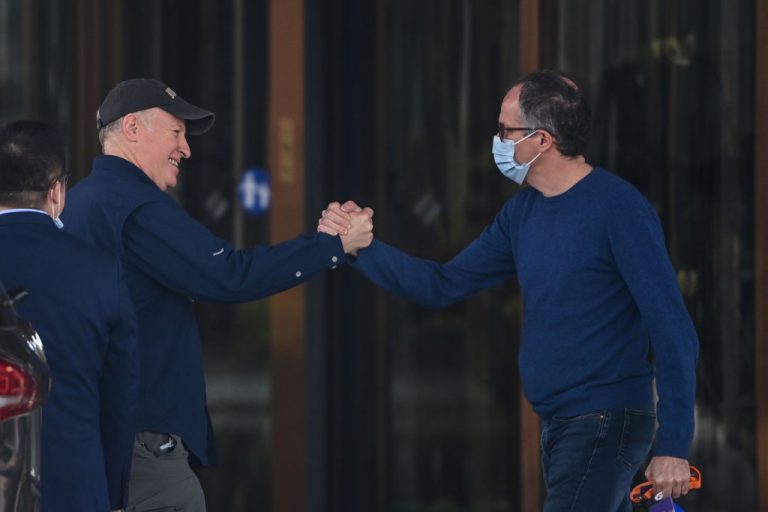Some of the loudest voices in the scientific community alleging the SARS-CoV-2 pandemic did not originate from the Chinese Communist Party’s (CCP) only Biosecurity Level 4 lab, the Wuhan Institute of Virology (WIV), are also ones with documented conflicts of interest, recent investigations reveal.
Facts reveal a number of experts, some of whom have been handed substantial grants by the U.S. government, teamed up with the WIV’s infamous Shi Zhengli to perform gain of function research on corona viruses.
On April 27, National Pulse published an article revealing NBC contributor and Founder of Tricorder Health, Joseph Fair was linked to the WIV after he “paid a one-day academic visit to Wuhan Institute of Virology at the invitation of Shi Zhengli, researcher of the Institute,” according to the Wuhan Institute of Virology’s own web page.
In March of 2020 when the pandemic first began, Fair fired off at former president Donald Trump’s administration on Twitter, saying Washington should leave the Wuhan institute out of the pandemic discussion, “Stop blaming China, Obama, & everyone else. Take responsibility & lead. Stop complimenting yourself & worry about Americans who are afraid for their lives, livelihoods, & futures.”
The same day, Fair also tweeted from his iPhone, “That shows a lot [sic] presidential maturity. The first conspiracy theory was that this was released from a lab in China. I respectfully disagree with you. He’s called it that despite his own CDC & HHS directors saying it’s incorrect.”
Success
You are now signed up for our newsletter
Success
Check your email to complete sign up
National Pulse also says that Fair was not shy about showering laurels upon the WIV, “Fair’s Twitter account also contains posts describing WIV researchers as ‘collaborators,’ ‘colleagues’ and ‘friends,’ adding ‘I’ve very much enjoyed working with them over the years’,” and that Fair showered praise upon the WIV for its “openness with regards to sharing data.”
Another outspoken professional is Ian Lipkin, who told CBS in a March 27, 2021 article that there was “no evidence” SARS-CoV-2 was laboratory-created or that it could have been released from a lab.
Like Joseph Fair, Lipkin also attended the WIV in 2015 as an ally of Bat Woman, according to the Institute’s own website, “Walter Ian Lipkin, a professor at the Center for Infection and Immunity in Mailman School of Public Health of Columbia University, paid a visit to WIV for communication. He had given an excellent report on ‘Small game hunting’, which was presided by Professor Zhengli Shi, to the teachers and students in our institute.”
Lipkin was promoted by CCP propaganda organs Global Times and CGTN. He told CGTN “I have so many friends in China, in universities, and in government that I can help people to talk to one another and work together,” while Global Times ran a promotional article headlining Lipkin entitled “Renowned Epidemiologist Walter Lipkin Lauds China’s Transparent and Professional Approach Against Coronavirus Outbreak” on March 2, 2020.
In May of 2020, Elodie Ghedin appeared on 60 Minutes attempting to debunk the lab leak theory. In 2016, Ghedin had been a Plenary Speaker at the WIV’s Viral Infection and Immune Response conference held in Wuhan City.
WHO Investigator Peter Daszak and EcoHealth Alliance
Perhaps the most notorious conflict of interest, however, is that of World Health Organization Investigator Peter Daszak and his EcoHealth Alliance, which has received millions of dollars in funding from the U.S. government.
Before the investigation began and throughout the earliest days of the pandemic, Daszak decried insinuations that the virus originated from WIV and was outspoken against the Trump administration. After the investigation, Daszak said we would know the origin of the virus fairly soon, but clarified that “fairly soon” meant he was “convinced we’re going to find out fairly soon within the next few years.”
The conflicts of interest around the WHO’s trip were so egregious that the Wall Street Journal Editorial Board published a Feb. 15 article entitled Who Are the COVID Investigators? Daszak was called out by name, “One prominent member of the WHO team is zoologist Peter Daszak. Also part of the Lancet COVID-19 Commission, Mr. Daszak has vowed to investigate ‘with an open mind’ and ‘not be bound by preconceived ideas.’”

The article continued, “Yet emails obtained by the nonprofit U.S. Right to Know show that Mr. Daszak long ago made up his mind about the lab-leak theory. In February 2020, he helped organize a statement in the Lancet condemning ‘conspiracy theories suggesting that COVID-19 does not have a natural origin.’ In one email, Mr. Daszak wrote that the document should ‘not be identifiable as coming from any one organization or person.’ But EcoHealth Alliance, the global nonprofit he leads, played an outsize role.”
In an August 2020 article published in Nature, the publication ensured there was no mistake of Daszak and EcoHealth’s connection to Shi and the WIV, “To carry out its research, EcoHealth Alliance partners with the Wuhan Institute of Virology (WIV) in China.”
The article also states, “EcoHealth Alliance and Daszak have been working with Shi Zhengli, a virologist at the WIV, for more than 15 years. Since 2014, an NIH grant has funded EcoHealth’s research in China, which involves collecting faeces and other samples from bats, and blood samples from people at risk of infection from bat-origin viruses.”
Daszak co-authored a scientific paper Discovery of a rich gene pool of bat SARS-related coronaviruses provides new insights into the origin of SARS coronavirus, with Chinese virologists affiliated with the WIV, published in 2017.
On April 16, animal rights advocacy group White Coat Waste Project revealed Daszak and EcoHealth received more than $9 million in grants from the Departments of Defense and Health and Human Services in 2020 alone.
However, the Project was primarily irate that EcoHealth received two separate Paycheck Protection Plan bailouts amounting to nearly $1.5 million combined from U.S. taxpayers.
Meanwhile, investigative reporter Sharyl Attkisson found from EcoHealth’s 2018 IRS filings the organization received millions in funding from U.S. agencies and vaccine manufacturer Johnson & Johnson:
EcoHealth’s top 5 contributors in 2018:
- $11.5 million: from the U.S. Agency for International Development (USAID)
- $783,412: from the U.S. Dept. of Homeland Security (DHS)
- $2.5 million: from the U.S. Dept. of Defense
- $900,000: from vaccine manufacturer Johnson and Johnson
- $601,474: from the U.S. Dept. of Health and Human Services (HHS)
Daszak and EcoHealth’s work in gain of function research was further exposed in a January article by Taiwan News, which pointed out Daszak spoke with Vincent Racaniello on Episode 615 of This Week in Virology, where he discussed conducting “surveillance of bats” in “Southern China.” Daszak said they found “Over a hundred new SARS-related corona viruses. Very close to SARS. Some of them get into human cells in the lab. Some of them can cause SARS disease in humanized mice models, and are untreatable with therapeutics…and you can’t vaccinate against them with a vaccine.”
The video was posted on May 18, 2020 on YouTube and May 19, 2020 on the TWIV website. However, both Taiwan News and Gateway Pundit maintain that the interview was originally filmed on December 9, 2019 at the Nipah Virus International Conference in Singapore, shortly before the pandemic first broke out in Wuhan.
Gateway Pundit claims “A copy was posted in May 2020.”
In his interview with TWIV, Daszak said of the coronavirus family, “You can manipulate them in the lab pretty easily. The spike protein drives a lot of what happens with the coronavirus, zoonotic risk.” He then mentioned his work with Ralph Baric and the University of North Carolina, “So you can get the sequence, you can build the protein, and we worked with Ralph Baric at UNC to do this, inserting the backbone of another virus and do some work in the lab.”
All of this linked into creating a vaccine against a coronavirus causing a SARS-like disease, “Now, the logical progression for vaccines is, if you are going to develop a vaccine for SARS, people are going to use pandemic SARS, but let’s try to insert these other related diseases and get a better vaccine,” said Daszak.
The curious case of UNC’s Ralph Baric
The man Peter Daszak worked with, University of North Carolina’s Ralph Baric, while having open ties to Shi Zhengli and the WIV, has, by comparison to the others, never tried to debunk the Wuhan lab leak theory.
In fact, Baric has made some very major revelations about the state of virology research. In a November 2020 segment by Italian broadcaster Rai, Baric, who was personally interviewed in the segment, was confirmed to have worked in 2015 with Shi, who was described as “One of the greatest synthetic virus building experts,” and Baric as “The greatest coronavirus expert in the world.”
Rai says the duo worked together to “construct a hybrid virus.”
According to Atkinsson, Baric’s 2015 study with the WIV was also funded by the NIH.
Baric, when discussing virus sequences for bat coronaviruses available to scientists, makes a shocking revelation, “We had no access to the viruses in China. All we had was access to the sequence.”
Explaining further, he states “And so you can chemically synthesize the sequence of the virus in the laboratory and make the virus sequence and then recover the virus.”
When Baric is asked by Rai’s reporter: “Did you give the virus a boost? Did you strengthen it?” referring to the new “chimera” in his study, he replied, “The only gain of function that occurred in that virus is that we changed its antigenicity. And what that data tells you is that any vaccine or antibody that you’d made against the original virus from 2003 [SARS-CoV] wasn’t going to protect the public from this new virus if it should emerge in the future.”
The reporter then asked Baric whether, if experts were to look at the genome of his chimera virus, they would be able to realize it was made in a laboratory, “Anything that we build in the laboratory has what are called signature mutations…It’s like where you sign your name almost. It says, if you put in these mutations then it says ‘this was built from material in the Baric laboratory.’”
Baric was then asked whether it was possible to create a virus in the laboratory that was indistinguishable from one occurring in nature, “It is correct. You can do it without leaving a signature, yes. Using any of three or four different approaches for coronaviruses that were developed by different researchers, you can leave no trace that it was made in a laboratory.”
“If you think that people can engineer a virus genome and that it’d be infectious and leave no trace, they have to start from a template from somewhere. You have to have a sequence to begin with. You can’t just put a sequence together to make a virus.”
The reporter then asked Baric point-blank if he would rule out whether SARS-CoV-2 was a “chimera made in a laboratory.” Baric’s response differed from those of others who have teamed up with Shi Zhengli and the WIV, “Not with the viruses that have been sequenced and reported to date.”
Also asked about whether there were viruses “we know nothing about in laboratories,” the implication of his reply was compelling, “That’s certainly possible. If you’re asking about intent, or whether the virus existed beforehand, it would only be within the records of the Institute of Virology in Wuhan.”














